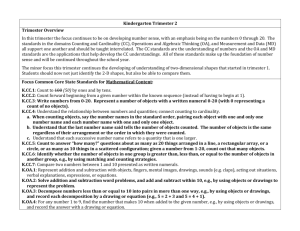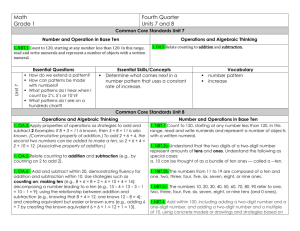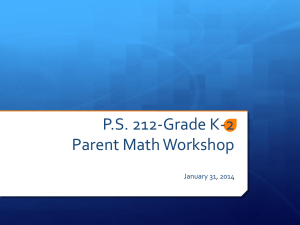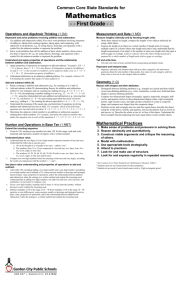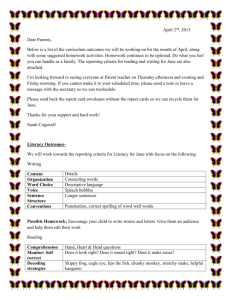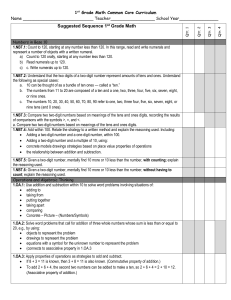1st Grade Math
advertisement
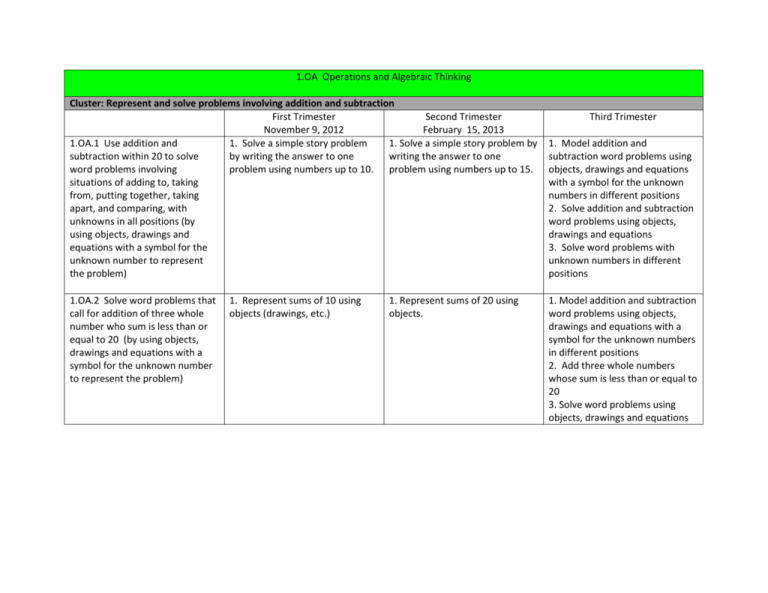
1.OA Operations and Algebraic Thinking Cluster: Represent and solve problems involving addition and subtraction First Trimester Second Trimester November 9, 2012 February 15, 2013 1.OA.1 Use addition and 1. Solve a simple story problem 1. Solve a simple story problem by subtraction within 20 to solve by writing the answer to one writing the answer to one word problems involving problem using numbers up to 10. problem using numbers up to 15. situations of adding to, taking from, putting together, taking apart, and comparing, with unknowns in all positions (by using objects, drawings and equations with a symbol for the unknown number to represent the problem) 1.OA.2 Solve word problems that call for addition of three whole number who sum is less than or equal to 20 (by using objects, drawings and equations with a symbol for the unknown number to represent the problem) 1. Represent sums of 10 using objects (drawings, etc.) 1. Represent sums of 20 using objects. Third Trimester 1. Model addition and subtraction word problems using objects, drawings and equations with a symbol for the unknown numbers in different positions 2. Solve addition and subtraction word problems using objects, drawings and equations 3. Solve word problems with unknown numbers in different positions 1. Model addition and subtraction word problems using objects, drawings and equations with a symbol for the unknown numbers in different positions 2. Add three whole numbers whose sum is less than or equal to 20 3. Solve word problems using objects, drawings and equations 1.OA Operations and Algebraic Thinking Cluster: Understand and apply properties of operations and the relationship between addition and subtraction. First Trimester Second Trimester Third Trimester 1.OA.3 Apply properties of NA 1. List compliments of numbers 1. Show that adding zero to any operations as strategies to add 2. Write turn around facts using number does not change the and subtract.3 Examples: single digits. number. If 8 + 3 = 11 is known, then 3 + 8 = 2. Show that changing the order 11 is also known. (Commutative of the addends does not change property of addition.) To add 2 + 6 the sum. + 4, the second two numbers can 3. Show when adding three be added to make numbers in any order the sum a ten, so 2 + 6 + 4 = 2 + 10 = 12. does not change. (Associative property of addition.) 4. Use properties of operations to add and subtract. 1.OA.4 Understand subtraction as NA an unknown-addend problem. For example, subtract 10 – 8 by finding the number that makes 10 when added to 8. 1. Solve problems involving simple function machines. 2. Find compliments of numbers up to 20. 1. Model and explain how a subtraction equation can be rewritten as an addition equation. 2. Rewrite a subtraction equation as an addition equation with a missing addend. 1.OA.5 Relate counting to addition and subtraction (e.g., by counting on 2 to add 2). 1.OA Operations and Algebraic Thinking Cluster: Add and subtract within 20. First Trimester Second Trimester 1. After counting by 5s continue After counting by 5s/10s counting counting on by 1s on by 1s. Third Trimester 1. Add by counting all, counting on, and recognizing the + 1 means the next number and +2 means the next next number in the counting sequence. 2. Subtract by counting up from, and recognizing the -1 means the number before and -2 means the number that is two numbers before in the counting sequence. 1.OA.6 Add and subtract within 20, demonstrating fluency for addition and subtraction within 10. Use strategies such as counting on; making ten (e.g., 8 + 6 = 8 + 2 + 4 = 10 + 4 = 14); decomposing a number leading to a ten (e.g., 13 – 4 = 13 – 3 – 1 = 10 – 1 = 9); using the relationship between addition and subtraction (e.g., knowing that 8 + 4 = 12, one knows 12 – 8 = 4); and creating equivalent but easier or known sums (e.g., adding 6 + 7 by creating the known equivalent 6 + 6 + 1 = 12 + 1 = 13). 1. Know easy addition facts to sums of 10. (one digit numbers, using die, dominoes or other manipulatives) 2.Use a number grid to solve an addition problem up to 20 3. Use frames and arrows to solve addition and subtraction problems and recognize the rule 4. Write the number model to represent a subtraction problem 1. Know easy addition facts to sums of 15. ( using die, dominoes or other manipulatives) 2. Use frames and arrows to solve addition and subtraction problems and recognize the rule 3. Model addition and subtraction within 15 by using equal but easier numbers (doubles, doubles +1, doubles -1) 1. Model addition and subtraction within 20 with ease. 2. Model addition and subtraction within 20 by counting on and making a ten 3. Model addition and subtraction within 20 by using the relationship between addition and subtraction. 4. Model addition and subtraction within 20 by using equal but easier numbers (doubles, doubles +1, doubles -1) 1.OA Operations and Algebraic Thinking Cluster: Work with addition and subtraction equations. First Trimester Second Trimester 1. Explain that the equal sign means “same as”. 1.OA.7 Understand the meaning NA of the equal sign, and determine if equations involving addition and subtraction are true or false. For example, which of the following equations are true and which are false? 6 = 6, 7 = 8 – 1, 5 + 2 = 2 + 5, 4 + 1 = 5 + 2. 1.OA.8 Determine the unknown 1. Solve parts-and –total number whole number in an addition or stories. subtraction equation relating three whole numbers. For example, determine the unknown number that makes the equation true in each of the equations 8 + ? = 11, 5 = � – 3, 6 + 6 = � 1. Solve parts-and –total number stories and explain how they got their answers. 2. Write fact families for dominoes up to 10. Third Trimester 1. Explain that the equal sign means “same as”. 2. Compare the value of both sides of an equation and determine whether the equation is true or false. 1. Determine the unknown value in an addition or subtraction equation when two out of the three numbers are given. 1.NBT.1 Count to 120, starting at any number less than 120. In this range, read and write numerals and represent a number of objects with a written numeral. 1.NBT Number and Operations in Base Ten Cluster: Extend the counting sequence. First Trimester Second Trimester 1. Count forward by 1’s, 2’s and 1. Write numbers to 100 5’s to 20 2. Order whole numbers through 2. Write the numbers that come 100 before and after a given numbers 3. Count forward and back by 1’s, up to 50. 2’s and 5’s to 20 3. Write tally marks for numbers 4. Use skip counting to count by (set of 5) up to 20. 2’s, 5’s and 10’s to 100 4. Write numbers to 50 5. Equivalent names for numbers 5. Count hops on a number line recognizing tally marks to 25. and end on the correct number. 6. Mentally add multiples of 10. 6. Use number grid to decide *Patterns – even and odd also what number comes before, between or after another number 7. Find equivalent names for numbers using tally marks to 20 8. Use skip counting to count by 2’s, 5’s and 10’s to 50 *Patterns – even and odd also Third Trimester 1. Model counting to 120. 2. Model counting to 120 starting from any number. 3. Read any number up to 120. 4. Write any number up to 120. 5. Label a set of objects up to 120 with a written numeral. 1.NBT Number and Operations in Base Ten Cluster: Understand place value. First Trimester Second Trimester 1.Identify digits in the ones and tens place. 1.NBT.2 Understand that the two digits of a two-digit number represent amounts of tens and ones. Understand the following as special cases: a. 10 can be thought of as a bundle of ten ones — called a “ten.” b. The numbers from 11 to 19 are composed of a ten and one, two, three, four, five, six, seven, eight, or nine ones. c. The numbers 10, 20, 30, 40, 50, 60, 70, 80, 90 refer to one, two, three, four, five, six, seven, eight, or nine tens (and 0 ones). NA 1.NBT.3 Compare two two-digit numbers based on meanings of the tens and ones digits, recording the results of comparisons with the symbols >, =, and <. 1. Understanding the greater number when comparing two numbers or quantities to 20. 2. Tell what number is one more or one less up to 50 1. Compare two two-digit numbers to determine greater than, less than or equal to with numbers up to 50. Third Trimester 1. Represent 10 as ten ones. 2. Represent the numbers 11-19 as a ten and some ones. 3. Represent multiple sets of ten using number names (2 tens is 20). 4. Explain the value of each digit in a two digit number (place value). 1. Determine when a two-digit number is greater than, less than, or equal to another two-digit number. 2. Can explain why a two digit number is greater than, less than, or equal to another two digit number. 3. Can record the comparison using the symbols >,<, = 1.NBT.4 Add within 100, including adding a two-digit number and a onedigit number, and adding a twodigit number and a multiple of 10, using concrete models or drawings an strategies base on place value, properties of operations, and/or the relationship between addition and subtraction; relate the strategy to a written method and explain the reasoning used. Understand that in adding twodigit numbers, one adds tens and tens, ones and ones; and sometimes it is necessary to compose a ten. 1.NBT.5 Given a two-digit number, mentally find 10 more or 10 less than the number, without having to count; explain the reasoning used. 1.NBT.6 Subtract multiples of 10 in the range 10-90 from multiples of 10 in the range 10-90 (positive or zero differences), using concrete models or drawings and strategies based on place value, properties of operations, and/or the relationship between 1. Adds two one-digit numbers up to sums of 18. 1. Read, write and represent whole numbers through hundreds with base-10 blocks. Compare whole numbers through 100. 1. Explain that the equal sign means “same as”. 2. Compare the value of both sides of an equation and determine whether the equation is true or false. 1. Use concrete models or drawings to show a strategy based on place value. (applying the operation properties to add the following): Two-digit and one digit number Two-digit number and a multiple of ten Two-digit number and a two-digit number 2. Write and explain the steps that were used in models or drawings to show addition. 1. Use the number grid to recognize patterns of multiples of ten up to 100. 1. Mentally add multiples of ten. 1. Mentally find 10 more for any two-digit number. 2. Mentally find 10 less for any two-digit number. 3. Explain why the tens digit increases or decreases by 1 when 10 is added or subtracted. NA N1. Use the number grid to recognize patterns of multiples of tens in subtraction. 1. Subtract a multiple of ten from a multiple of ten. 2. Explain a strategy for subtracting a multiple of ten from a multiple of ten. 3. Explain how subtracting by a multiple of ten is related to subtracting the tens digits. addition and subtraction; relate the strategy to a written method and explain the reasoning used. 1.MD Measurement and Data Cluster: Measure lengths indirectly and by iterating length in units. First Trimester Second Trimester Third Trimester 1.MD.1 Order three objects by length; compare the lengths of two objects indirectly by using a third object. 1. Compare the length of two objects 1. Using the correct starting point when measuring 1. Can recognize when an object is longer or shorter than another object. 2. Can organize three objects by length in order from shortest to longest. 3. Can compare the lengths of two objects by using a third object. 1.MD.2 Express the length of an object as a whole number of length units, by laying multiple copies of a shorter object (the length unit) end to end; understand that the length measurement of an object is the number of same size length units that span it with no gaps or overlaps. Limit to contexts where the object being measured is spanned by a whole number of length units with no gaps or overlaps. NA 1. Measure to the nearest inch. 2. Measure to the nearest foot using an inch ruler. 1. Will explain how to use a shorter object to measure the length of a longer object and explain why it is important to avoid gaps and overlaps. 2. Will report the length of an object as the total number of shorter objects it takes to span the longer object without gaps and overlaps. 3. Will represent the length of the longer object with a whole number. Measurement and Data Cluster: Tell and write time 1.MD.3 Tell and write time in hours and half-hours using analog and digital clocks First Trimester November 9, 2012 1. Draw the hour hand pointing to the correct number. 2. Can look at an analog clock and say what time it is to the hour Second Trimester February 15, 2013 1. Can identify a digital and an analog clock 2. Can identify the hours and minutes on a digital and analog clock 3. Can tell how many minutes are in an hour 4. Can explain why 30 minutes is a half hour 5. Can look at the time on an analog clock (when the hour hand is pointing to 12 or 6), say what time it is, and draw in the hands on an digital clock 6. Can look at the time on a digital clock (when the minutes is displayed as :00 or :30), say what time it is, and draw in the hands on an analog clock 7. Can write the time and draw in the hands on an analog clock when someone tells me what time it is (when the time is stated as “_o’clock” or “_thirty” or “half past _” X Measurement and Data Third Trimester 1. Can identify a digital and an analog clock 2. Can identify the hours and minutes on a digital and analog clock 3. Can tell how many minutes are in an hour 4. Can explain whey 30 minutes is a half hour 5. Can look at the time on an analog clock (when the hour hand is pointing to 12 or 6), say what time it is, and draw in the hands on an digital clock 6. Can look at the time on a digital clock (when the minutes is displayed as :00 or :30), say what time it is, and draw in the hands on an analog clock 7. Can write the time and draw in the hands on an analog clock when someone tells me what time it is (when the time is stated as “_o’clock” or “_thirty” or “half past _” Cluster: Represent and interpret data 1.MD.4 Organize, represent, and interpret data with up to three categories; ask and answer questions about the total number of data points, how many in each category, and how many more or less are in one category than in another. CAS – Money – First Trimester November 9, 2012 1. Ability to read a tally chart. 2. Write tally marks up to 30. 1. Know the value of a penny, nickel and dime 2. Count nickels and pennies separately 3. Count coin combinations using 2 coins (nickels and pennies ) 4.Show amount Second Trimester February 15, 2013 1. Answer probability questions 2. Give temperature to nearest 10 degrees. 3. Correctly interpret a bar graph to determine the correct data. Third Trimester 1. Can organize data in up to three categories (group) 2. Can represent data in up to three categories 3. Can answer questions about the total number of data points and how many data points are in each category 4. Can determine when a category has more or less than another category 1. Show amount by using fewer 1. Count coin combinations using coins 2 coins (quarters, dimes, and 2.Count coin combinations using 2 pennies) coins (dimes, nickels and pennies) Geometry Cluster: Reason with shapes and their attributes 1.G.1 Distinguish between defining attributes (e.g., triangles are closed and three-sided) vs. non – defining attributes (e.g., color, orientation, overall size); build and draw shapes to possess defining attributes. 1.G.2 Compose two –dimensional shapes (rectangles, squares, trapezoids, triangles, half-circles, and quarter – circles) or threedimensional shapes (cubes, right rectangular prisms, right circular cones, and right circular cylinders) to create a composite shape, and compose new shapes form the composite shape. 1.G.3 Partition circles and rectangles First Trimester November 9, 2012 NA Second Trimester February 15, 2013 NA Third Trimester NA NA 1. Can identify two-dimensional shapes. 2. Can create new shapes using two – dimensional and/or threedimensional shapes. NA NA 1. Can partition (divide) a circle and rectangle into two and four 1. Can explain the differences between defining attributes (e.g., sides, angles, faces) and nondefining attributes (e.g., color, orientations, overall size). 2. Can construct and draw a shape when given defining attributes. into two and four equal shares, describe the shares using the words halves, fourths, and quarters, and use the phrases half of, fourth of, and quarter of. Describe the whole as two of, or four of the shares. Understand for these examples that decomposing into more equal shares creates smaller shares. equal parts. 2. Can describe the equal parts of a circle and rectangle with words (halves, fourths, and quarters). 3. Can describe the whole by the number of equal parts (e.g., two halves make a whole). 4. Can explain the more equal parts in a given shape, the smaller the parts.

